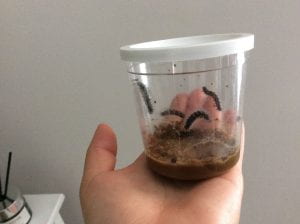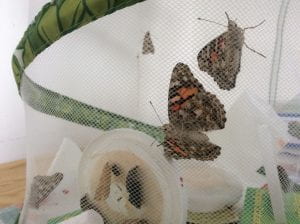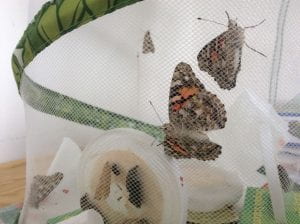
This is a diary of our little Caterpillars. I will update this page every day so you can see how much they change. I am very excited to see every stage. Are you? Ask all your questions in the comments, and I will try to answer them. If I don’t know the answer then we can research the answer together.

1 day old – 10 little caterpillars. What should we call them? The brown paste at the bottom of the tubs is their food. The caterpillars are growing so fast.

Day 2 – The instructions say that you need to wrap them up in a blanket or sock to keep them warm. They do not like it to be too bright, so they need a dark and dry place to live. We have put them safely in Henry’s room. Can you see how much they have grown in just 1 day.


Day 4 – the caterpillars are getting so big now. You can see their hairy bodies and little legs. The caterpillars all seem to be different lengths. There’s some long and some shorter caterpillars. Each one is different.




Day 5 – I have noticed that the caterpillars have started to make a web. I did not know they did that so I researched it. These caterpillars are called ‘Painted Ladies’. This species spins a silky webbing around themselves to keep them safe and to stop them following off the leaf. They’re like a protective silk tent. Apparently, if the caterpillars are doing this in the pot then it means they are happy and feel safe. That is nice to know. Can you see their hairy bodies and little legs. Some of the caterpillars are still small but some have grown so much! Today, can you have a think about ‘Painted Lady’ caterpillars. Why do you think they are called Painted Lady?
Day 6 – I noticed little black bits at the bottom. I thought it was part of a caterpillar and I quickly counted I still had 5 in each pot. Apparently the little black balls are called ‘frass’ and it is caterpillar poo! It means they are healthy and eating lots to grow bigger.
Day 7 – The caterpillars have now started to shed their first skin. Like snakes, caterpillars shed their skin as they grow. The caterpillars will shed their skin five times. They shed four times whilst they are growing bigger, and then once more just before they attach themselves to the lid of the cup in preparation to turn into the pupate.
cocoon meaning – the silk casing that a caterpillar spins around itself before it turns into a pupa. Its the protective casing around the chrysalis.
Pupa and chrysalis meaning – transformation stage between the caterpillar and the butterfly. It starts as a pupa and that as the butterfly develops, we refer to the pupa as a chrysalis.
https://www.insectlore.com/pages/butterfly-questions
The link above has lots of answers to questions you may have.
Day 8 – The caterpillars are eating so much these days. I am worried they will run out of food before they turn into a pupa.
Day 9 – The caterpillars are so wiggly and active today. Caterpillars don’t have bines in their body. They move by squeezing muscles in a sequence like a wave motion. You can see the wave motion as they move along the outside of the cup. You can also see the little legs and suction cups underneath. The suction cups help the caterpillar to move along the side of the cup. They have also started to get a white tummy. They are black/dark brown on top. Can you see the white tummy in the photo?
Day 10 – Something really exciting is happening. Some of the caterpillars have started to hang from the top of the cup. The L shape means that they are getting ready to shed their skin one last time, and turn into a pupa.
Day 11 – More of the caterpillars are hanging in an L shape now. I have noticed something in one of the pots. One of the caterpillars seems to have started turning into a pupa but must have fallen from the top of the pot. Can you see that it looks different on the outside. I am going to wait until the others are hanging and then try and save it. I have done some research and I need to put it near the netting side of the Butterfly home. It won’t be long before they are all hanging in a L shape.
Look back at the first picture. They were so tiny. Haven’t they grown so much?
 Can you see the gold coloured line on the pupa?
Can you see the gold coloured line on the pupa?
Day 12 and 13 – The caterpillars have all now turned into a pupa or are hanging from the top ready to turn into a pupa. Unfortunately, four have now dropped to the bottom of the cup. I am hoping that I can rescue them. I have read that I need to scoop them up with a spoon and carefully put them on kitchen roll near the inside of the butterfly net. I will do this in a couple of days when all the caterpillars have turned into pupa. I will show you the next stage on here. The last photo is the butterfly net where I will transfer the pupae to.
Day 15 and 16 – I have moved the caterpillars into the butterfly home. Some of them wiggled to warn me off. The ones that had fallen to the bottom are not all wiggling. We will have to see whether they have survived. I have added the video of me transferring the caterpillars. It was a fiddly job. an you spot the black blobs? Those are the caterpillars skins that they have shed. The last picture shows you the food and frass.
I will keep an eye on them but it will be a few days before they start to change again. What changes should I expect to see?
Day 16 – 21
The chrysalis are not doing very much, but I keep checking on them.
EXCITING NEWS!!!!!!
Day 21 – 23
Butterflies have started to emerge. I managed to get a video of the process. It was so exciting. I wish you could have seen it happen as originally planned. We will have to do it again next year and you can come and have a peep in the Reception Classroom.
Not all the butterflies have emerged yet. Some are still as a chrysalis. I will release them when most of them are ready. The butterflies emerge all crinkled. They attach to the side and dry their wings. The wings eventually then spread out. The red liquid you can see is not blood. It is called meconium. It means the butterflies are healthy. When the butterflies first emerge their tongue is in two strands. They roll the tongue. The two tongue pieces connect to make a tube like tongue. They use this tube to suck up nectar.
The butterflies have lived on fruit, nectar and flowers.
Today, we set 6 of the 10 butterflies free. The others were not ready yet.
The colours on the top/inside of the wings are bright. This is to warn off predators and to attract a mate.
The colours on the outside and underneath the wings are brown. Why do you think this is? What do you notice when the wings are closed? Can you see the caterpillar on the leaf? It is camouflaged to hide from predators.
I noticed that the caterpillars loved the apple trees and strawberry plants. I was having a good look when I noticed balls of webs. I thought they were spider eggs, but when I looked closer, I could see tiny caterpillars. Can you see the caterpillars?
Look at the empty chrysalis. What can you see?
Today, we let 3 out of the remaining 4 free. Unfortunately, I don’t think the last one has survived. It was the one that had fallen into the crass and food at the bottom of the tub. I will keep an eye on it, but I may have to put it to rest in my flower garden.
I loved watching the life cycle of a butterfly. Did you?
I wonder if you could draw your own butterfly life cycle?
I wonder what our Butterflies are doing now. What adventures are they on? Maybe you could write a story about one of our butterflies. You could tell me all about the exciting adventures the butterflies are doing right now.



































